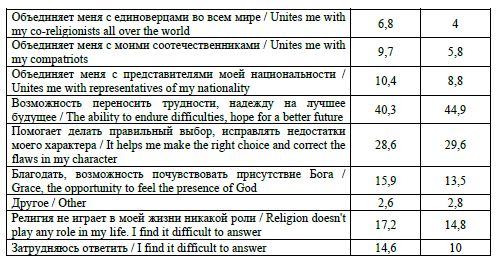The dynamics of religiosity among provincial students
The article analyzes the main characteristics and trends in the dynamics of religiosity among provincial students using the example of students at National Research Mordovia State University. Based on a comparison of the data from the 2024 and 2025 questionnaires, changes in the level and degree of religiosity are characterized according to the main parameters of the multidimensional approach of C. Glock and R. Stark, the subjective significance of religious norms of behavior is assessed, and the main trends in students' assessment of the role and functions of religion in modern Russian society are identified. The authors of the article characterize the religiosity of students as a whole as “fuzzy”, privatized and distanced in relation to the institutional forms of religion with which individuals identify themselves on the basis of cultural tradition, and conclude that the identified complex of characteristics of religiosity among students is stable. Despite a slight decrease in religiosity noted by researchers in other regions, religious students as a whole remain above average in terms of faith and experience, while remaining relatively low in terms of ritualistic, intellectual and behavioural dimensions (though not lower than in the region as a whole). In particular, the consistently declared recognition by students of the public role of religion as a social regulator and a means of transmitting cultural values does not give grounds to conclude that it is possible to change their behavior in everyday life through the authority of traditional religions and micro-level relations with their bearers. Using the example of this social category, it is clearly seen how modern believers consider religion not as a set of ready-made prescriptions, but as a guideline for individual moral choice and a means of solving an individual's existential problems.
Figures







Bogatova, O. A., Chuikova, O. G. (2025), “The dynamics of religiosity among provincial students”, Research Result. Sociology and Management, 11 (2), 63-84. DOI: 10.18413/2408-9338-2025-11-2-0-5


















While nobody left any comments to this publication.
You can be first.
Bezniuk, D. K. (2020), “Crisis of faith or faith in crisis”, Journal of the Belarusian State University. Sociology, (2), 124-128, DOI: 10.33581/2521-6821-2020-2-124-128, EDN: DHCYVC. (In Russian)
Berger, P. (2019), Svyashhennaya zavesa. Elementy sotsiologicheskoy teorii religii [The Sacred Canopy: Elements of a Sociological Theory of Religion], Novoe literaturnoe obozrenie, Moscow, Russia. (In Russian)
Bogatova, O. A. (2017), “Religiosity of Student Youth: the Sociological Research in Region (Republic Mordovia)”, Vestnik Leningradskogo gosudarstvennogo universiteta imeni А. S. Pushkina, (3), 186-201, EDN: ZOWLBL. (In Russian)
Inglehart, R. (2022), Neozhidanny upadok religioznosti v razvityh stranah [Religion’s Sudden Decline], EUSPb, St. Petersburg, Russia. (In Russian)
Kublitskaya, E. A. (2022), “Dynamics of the post/de/secularization process among the youth Groups of the Moscow metropolis”, Research Result. Sociology and Management, 8(3), 103-115, DOI: 10.18413/2408-9338-2022-8-3-0-8, EDN: ETHFSU. (In Russian)
Kublitskaya, E. A. (2023), “The main values of the consolidation of Russian society in the views of religious and non-religious students”, Research Result. Sociology and Management, 9(2), 21-42, DOI: 10.18413/2408-9338-2023-9-2-0-3, EDN: PBFDES. (In Russian)
Lebedev, S. D. (2015), “The pro-orthodox consensus in Russia in the early XXI century as a phenomenon of religious situation”, Research Result. Sociology and Management, 1(1), 14-21, EDN: TWDDIT. (In Russian)
Motkin, V. N. (2024), “Regional interconfessional relations in the sociological dimension”, Aktualnye aspekty nauchnyh issledovaniy: sbornik statey II Mezhdunarodnoy nauchno-prakticheskoy konferentsii, 19 marta 2024 g. [Current aspects of scientific research: Collection of articles II International scientific and practical conference], March 19, 2024, Kubik, Saratov, Russia, 630-637, EDN: HMGHNC. (In Russian)
Prutskova, E. V., Markin, K. V. (2017), “Typology of orthodox Russians: the problem of constructing a generalized religiosity indicator”, Sotsiologicheskie issledovaniya, (8), 95-105, 10.7868/S0132162517080116, EDN: ZGOXSX. (In Russian)
Smirnov, M. Yu. (2008), “On religious studies, religion and religiosity”, Vestnik Russkoy khristianskoy gumanitarnoy akademii, 9(2), 62-73, EDN: KLSRJT. (In Russian)
Smirnov, M. Yu. (2023), “Permanent secularization or postsecular society? Modern transformations of religion in the perspective of research reflection”, Vestnik Leningradskogo gosudarstvennogo universiteta imeni A. S. Pushkina, (3), 134-152, DOI: 10.35231/18186653_2023_3_134, EDN: URLOHB. (In Russian)
Taylor, Ch. (2017), Sekuljarny vek [A Secular Age], BBI, Moscow, Russia. (In Russian)
Ushkin, S. G. (2024), “Not only social networks: channels of dissemination of fake news in the views of the population”, Galactica Media: Journal of Media Studies, 6 (2), 162-176, DOI: 10.46539/gmd.v6i2.460, EDN: YUXQRL. (In Russian)
Faulkner, J. E., de Jong G. F. (2011), “Religiosity in 5-D: an empirical analysis”, Sociologicheskie issledovanija, (12), 69-76, EDN: ONGKFL. (In Russian)
Habermas, Y. (2002), Budushhee chelovecheskoy prirody [The Future of Human Nature], Izdatelstvo Ves Mir, Moscow, Russia, ISBN: 5-7777-0171-X, EDN: SGUYVP. (In Russian)
Shirokalova, G. S., Dulina, N. V., Pronina, E. I. (2024), “Features of the religious consciousness of Nizhny Novgorod students”, Vestnik Instituta sotsiologii, 15(2), 46-60, DOI: 10.19181/vis.2024.15.2.4, EDN: ZDBXUY. (In Russian)
Hervieu-Léger D. (2015), “In search of certainties: the paradoxes of religiosity in societies of high modernity”, Gosudarstvo, religija, cerkov' v Rossii i za rubezhom, (1), 254-268, EDN: UIXFLH. (In Russian)
Berger, P. L. (2014), The Many Altars of Modernity. Toward a Paradigm for Religion in a Pluralist Age, Walter de Gruyter, Boston, Berlin.
Bruce, S., Voas, D. (2023), “Secularization vindicated”, Religions, 14(3), 301, 1-13.
Davie, G., Leustean, L. N. (2021), The Oxford Handbook of Religion and Europe, Oxford University Press, Oxford.
Davie, G. (2007), Vicarious Religion: A Methodological Challenge, Everyday Religion: Observing Modern Religious Lives, ed. by N. T. Ammerman. Oxford University Press, Oxford and New York, 21-35.
Glock, C. Y., Stark, R. (1974), American Piety: the Nature of religious Commitment, University of California Press, London, Berkeley and Los Angeles.
Hervieu-Leger, D. (2015), “Religion as a grammar of memory: reflections on a comparison between Britain and France”, Modernities, Memory and Mutations. Grace Davie and the Study of Religion, ed. by A. Day, M. Lövheim, Routledge, London and New York, 13-29.
Stolz, J., Künemann, J., Purdie, M.S., Englberger, T., Krüggeler, M. (2016), (Un)Believing in Modern Society. Religion, Spirituality, and Religious-Secular Competition, Routledge, Farnham.
Stolz, J., Lipps, O., Voas, D., Antonietti, J.-P. (2024), “Can we explain the generation gap in churchgoing?”, Journal for the Scientific Study of Religion, 63(4), 809-829.
Fenn, R. K. (ed.) (2003), The Blackwell Companion to Sociology of Religion, Blackwell Publishing, Oxford.
Voas, D. (2009), “The rise and fall of fuzzy fidelity in Europe”, European Sociological Review, 25 (2), 155-168.